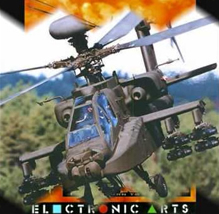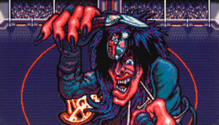Electronic Arts was one of the earliest game developers to really stretch out and tackle new video game hardware. Moving beyond computers, founder Trip Hawkins had the company developing for the NES, and he was one of the few companies that actually approached Sega about a license (“backed them into a corner” could be another way of putting it). Hawkins took a big gamble developing on a machine that directly competed with Nintendo’s, but time proved what a sound business decision that was. Electronic Arts went on to become one of the most powerful companies in the gaming industry.
 It would be interesting then, to have the perspective of someone who was there from before the Genesis days all the way through the Playstation era. Fortunately, we have such a person in Michael Lubuguin, one of the first employees to join EA. For over twelve years, Lubuguin worked in several positions, from customer service and game design to eventually producing. During his tenure, he worked on more games than you can shake a controller at, and he was involved in many Genesis-born series, such as Road Rash and the Strike series. Lubuguin was also a witness to the growth and domination of the Madden franchise. After leaving Electronic Arts in 1998, Lubuguin went to create games at Namco, Visual Concepts, and eventually Sega itself.
It would be interesting then, to have the perspective of someone who was there from before the Genesis days all the way through the Playstation era. Fortunately, we have such a person in Michael Lubuguin, one of the first employees to join EA. For over twelve years, Lubuguin worked in several positions, from customer service and game design to eventually producing. During his tenure, he worked on more games than you can shake a controller at, and he was involved in many Genesis-born series, such as Road Rash and the Strike series. Lubuguin was also a witness to the growth and domination of the Madden franchise. After leaving Electronic Arts in 1998, Lubuguin went to create games at Namco, Visual Concepts, and eventually Sega itself.
Mr. Lubuguin was kind enough to take some time and chat with Sega-16 about his experiences at Electronic Arts.
Sega-16: You were a computer graphics animator at Electronic Arts before moving on to the Genesis. Tell us a bit about that transition. How did it happen? Were you happy to move to consoles, or would you have preferred to continue working with PCs?
Michael Lubuguin: When SEGA introduced the Genesis, our production team at EA was very eager to see what that new machine could do. We wanted to be one of the first developers to release a game on that new platform so we were quite excited about the new opportunity. I was fortunate enough to be one of the initial team members working on porting our Budokan game to the Genesis. It was a definite learning experience. There were some limitations that we had to work with compared to what the PC could do, but we adjusted accordingly. Personally, I was happy to move over to consoles from the PC because of the potential to work on new technologies. I was always a gamer at heart, and though I respect the PC’s ability to be a competent “gaming” platform, I was intrigued and excited to be working on a dedicated gaming platform.
Sega-16: Having worked on the original PC versions of Lakers vs. Celtics and Budokan, what was your opinion of the Genesis ports? Did anyone ever come to you for input?
Michael Lubuguin: I was actually very impressed with how the Genesis versions of those games turned out. I thought that those particular titles were better suited to a gaming console because of their action arcade nature (i.e. sports action and martial arts fighting). Budokan did “look” better on the PC with the advanced graphics mode (256 colors on the PC), but I always found the PC joystick controls and the keyboard controls very awkward for that game in particular. I was consulted occasionally giving my opinions and suggestions, but the majority of the input came from the lead designers and the primary producers of those games.
Sega-16: You were at EA through its incredible growth period. How did you feel about the environment change from the early days of PC games to the rise of the Madden juggernaut?
Michael Lubuguin: It was an incredible ride. I felt very privileged to be a part of EA’s initial years (I joined in September of 1986 and was employee number 109). When I first joined, EA’s biggest hit at that time was a PC game called Starflight. We were small enough to be able to have our Friday meetings in a single conference room. There was an incredible camaraderie amongst all the employees and a genuine excitement in the workplace. We had NERF balls everywhere and would constantly throw them around the cubicles for fun. I had developed very close friendships with some of my colleagues that survive to this day. Trip Hawkins had fostered a very friendly work atmosphere. We worked hard but we also played hard as well. As the years progressed and we grew bigger, it was still a great place to be, but it became harder to maintain that tight-knit camaraderie as a whole and instead the individual production teams became like little “families”. We still had pride as a company, but with the increased size and growing number of production teams, a sense of “friendly competition” arose from the individual production teams (i.e. who is going to make the next cool game).
Sega-16: You worked on every single game in the STRIKE series, playing a first-hand role in its evolution. What was it like coming up with new ideas for each installment?
Michael Lubuguin: I have the fondest memories of my time at EA working with the STRIKE production team. They were some of the most dedicated and hard working folks that I have ever had the pleasure of working with. Each new iteration or sequel of the franchise was extremely exciting to work on. We would have memorable brainstorm sessions trying to come up with new ways to improve the franchise. We wanted to make it fresh and exciting, yet keep the heart and soul of the game which was essentially a “thinking man’s shooter.” It was definitely challenging though at times because we always had to keep a “reality check” on what we really could accomplish given the production schedule as well as any hardware limitations of the target platform. But we always maintained an extremely enthusiastic attitude through it all and really wanted to make the coolest game we could with the technology that we had to work with. Each later version of the game also provided us with opportunities to try and increase the “Hollywood” cinematic scope of the supporting story, and it was really fun coming up with the plot points and specific game scenarios that were inspired by memorable Hollywood action films of the time.
Sega-16: Mike Posehn said he was surprised that EA was able to port Desert Strike to the SNES, given the game’s size, and many gamers consider the series to be superior on the Genesis. What did you think of the SNES versions?
Michael Lubuguin: I remember seeing the first milestone deliveries of the SNES version and being very impressed with how much of the look and feel from the original was retained in the SNES version. I actually liked the graphics of the SNES version and thought that the graphics looked a little “softer” and it lent itself better to particular background elements. But I agree with many gamers and also thought that it was superior on the Genesis. I thought the SNES version was comparable, but personally given a choice, I would rather play the Genesis version.
Sega-16: Do you know why EA decided to let the series end?
 Michael Lubuguin: I’m not sure specifically why EA decided to let the series end. I imagine that it may have come down to profitability issues and perhaps a desire to move on to other IPs and develop other new original franchises. I always thought that the STRIKE series had a good following of fans, but I also know that in terms of sheer profitability, a franchise like Madden is more profitable in the end and would better warrant continued sequels. However, the ultimate decision to end the series was handled at the upper executive levels. Still, I would love to eventually see an updated Playstation 3 or XBOX 360 version of a STRIKE game. That would be awesome! There’s always hope.
Michael Lubuguin: I’m not sure specifically why EA decided to let the series end. I imagine that it may have come down to profitability issues and perhaps a desire to move on to other IPs and develop other new original franchises. I always thought that the STRIKE series had a good following of fans, but I also know that in terms of sheer profitability, a franchise like Madden is more profitable in the end and would better warrant continued sequels. However, the ultimate decision to end the series was handled at the upper executive levels. Still, I would love to eventually see an updated Playstation 3 or XBOX 360 version of a STRIKE game. That would be awesome! There’s always hope.
Sega-16: Road Rash is another EA franchise that rose to fame on the Genesis. Was EA ever concerned about a backlash to the violent content? After the Senate hearings on video game violence in ’93 and ’94, it seemed that a series like Road Rash would have been a prime candidate for controversy.
Michael Lubuguin: There may have been some concern about potential backlash to the violent nature of the game, but we didn’t want that to ultimately prevent us from making a fun and crazy racing game. When all is said and done, we wanted to make a cool game for the “gamers” and not be influenced to compromise ourselves because of public objections to the violence. I thought that we never overtly glorified the violence and just made it another element in the gameplay. It’s still essentially a racing game. Personally I understand that this can be a sensitive issue and I don’t want to downplay the seriousness, but ultimately in the end we wanted to make a fun cool video game for the masses.
Sega-16: Which of the three Road Rash games is your favorite? Why?
Michael Lubuguin: I would have to say that the original Road Rash is my favorite of the three, primarily because it was a new idea at the time it was very exciting to be working on something different. I also had more direct involvement in the first game (i.e. game elements, track design and layout, assistant producer tasking, etc.) than the later versions. The initial game also had a much smaller production team (the core team photo in the back of the manual is pretty much everyone who worked on the game). With a small production team, we had greater sense of camaraderie and teamwork and worked extremely well together. The team grew in size with the later versions as new folks were brought on board to help bring the games to market.
Sega-16: EA has been toying with the idea of bringing the series back. Do you think it would work now? Why or why not?
Michael Lubuguin: Personally I think it would actually do really well in the current market. Even though there are currently a lot of racing games out for all the platforms, most of the more popular ones seem to focus on auto racing. There are a few non-auto racing games, but not a lot of motorcycle racing games, and even fewer motorcycle racing games with the “dirty fighting” combat mechanics that Road Rash is famous for. I would love to see an “extreme” version of Road Rash for the current breed of consoles that offered not only combat motorcycle racing, but maybe even some other vehicle types as well (i.e. speedboats, ultralights(powered hang gliders), go-karts, etc.)
Sega-16: What did your team think of Sega’s NFL Football series? Was it ever considered a true threat to Madden?
Michael Lubuguin: We were generally impressed with what SEGA was able to accomplish with their football game. However we were very confident in what Madden could do and never really considered their NFL series as a threat to Madden. We respected what they did though but we were confident that in the end our fans would always come back to Madden. Personally, I think there’s always room for another good football game. Besides, competition breeds innovation because everyone is always trying to “one up” the next game, so ultimately in the end, the consumer wins. Also, the core members of the Madden production team are a passionate group of gamers and we were the most critical of any flaws in our game, always striving to make it better and to fix the flaws.
Sega-16: Did you ever think Madden would become as big as it did?
Michael Lubuguin: I had a feeling it would be popular but never imagined that it would turn out to be the “juggernaut” that it is today. I vividly remember one of the key producers at EA (Rich Hilleman) coming to me in my cube one day asking me over to his desk to check out a new “technology” demo that he just received from one of his outside developers. It was a bunch of animated football player sprites moving around on a scrolling angled football field. I was totally blown away and was extremely excited at the potential of what I saw. That “tech” demo eventually evolved into the first Madden on the Genesis, and I was eager to be involved in that franchise from the start. I was fortunate to be able to have worked on all the initial versions of Madden and felt that we were working on something really cool that would take off with the fans.
Sega-16: You said you were involved in all the initial versions of Madden. That includes the first Genesis release, which was done by Park Place Productions?
Michael Lubuguin: My involvement in Madden was primarily support testing as most of the actual development was done by an external developer. Generally as Madden was being made during those years, I was working on other projects, but was always put on Madden to help out. On Madden ’94 SNES, my responsibilities increased as I was assigned as the primary Assistant Producer on that version. My tasks on that version included managing the test team and working closely with the lead programmer (John Schappert) to oversee milestones and chase down bugs and problems, and to take care of all the submission requirements and tasks required by Nintendo. As to that initial “tech demo” that I mentioned for the first version, I was just privy to seeing the working prototype because I had a good working relationship with that producer, so as a favor and to solicit my “gamer” opinion, he wanted me to take a look at it.
Sega-16: I have to ask about Crüe Ball, as it’s such an odd choice for a game. Motley Crüe and Pinball? How did the concept come about?
Michael Lubuguin: That game was really fun to work on. That game though was primarily the brainchild of the producer I was working for at the time (Richard Robbins) and a wonderful programmer named Lou Haen who ran an outside developer called NuFX. Those two already came up with a cool concept. They showed me an early running prototype and once I saw what they initially had, I agreed with them that a pinball game would be a great vehicle for a distinct and unique art style and visual elements. I served as Assistant Producer on that title and had a great time doing it. I was able to help with design suggestions and gameplay enhancements. With each new milestone delivery we received from the developer, it was exciting to see the latest additions that the programmers added. Once the final Motley Crüe background music tracks were added in, then I knew we had something uniquely fun and different.
 Sega-16: Do you know how the Motley Crüe license was obtained for Crüe Ball? Did you ever get to meet the band?
Sega-16: Do you know how the Motley Crüe license was obtained for Crüe Ball? Did you ever get to meet the band?
Michael Lubuguin: The actual contract negotiations and license negotiation details were all taken care of by the primary producer (Richard Robbins) and our legal department. I was not involved in any of those dealings. So sadly, I never got a chance to actually meet any of the band members. As Assistant Producer on that game, my responsibilities mainly focused on overseeing the milestone deliveries, gameplay tuning, supervising testing and all the miscellaneous submission tasks required by Sega.
Sega-16 appreciates Mr. Lubuguin talking with us.

Recent Comments